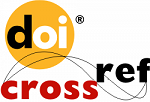Critical Thinking: How is it Developed with the Experiential Learning Model in Junior High School Students?
Abstract
This research aims to determine whether the achievement and improvement of mathematical critical thinking abilities of junior high school students who get the experiential learning model is better than those who get conventional learning and to find out which indicators of critical thinking abilities that junior high school students find difficult. This research is a quantitative research with a quasi-experimental research type. The design in this research was the randomized pretest-posttest control group design. The instrument used in this research is a set of tests to describe the mathematical critical thinking ability with a system of two-variable linear equations. The analysis used in this research using the t test, with a one-party hypothesis. Post-test data is used to see the achievement of mathematical critical thinking abilities and N-gain data to see the improvement. The conclusion in this research is the achievement and improvement of mathematical critical thinking abilities of students who receive experiential learning is better than the mathematical critical thinking abilities of students who receive conventional learning. There is aspect that students find difficult, namely the advanced clarification aspect.
Keywords
Full Text:
PDFReferences
Abdullah, A. A., Shanti, W. N., & Sholihah, D. A. (2020). Critical thinking ability through experiential learning in the calculus class. Journal of Physics: Conference Series, 1613(1). https://doi.org/10.1088/1742-6596/1613/1/012002
Aizikovitsh-Udi, E., & Cheng, D. (2015). Developing Critical Thinking Skills from Dispositions to Abilities: Mathematics Education from Early Childhood to High School. Creative Education, 06(04), 455–462. https://doi.org/10.4236/ce.2015.64045
Astuti, Y. K. (2016). Pembelajaran Berbasis Pengalaman (Experiental Learning) Untuk Meningkatkan Keterampilan Berfikir Kritis dan Aktivitas Mahasiswa. Jurnal Universitas Wiralodra, 7(3), 148–152.
Chesimet, M. C., Githua, B. N., & Ng’eno, J. K. (2016). Effects of Experiential Learning Approach on Students’ Mathematical Creativity among Secondary School Students of Kericho East Sub-County, Kenya. Journal of Education and Practice, 7(23), 51–57. Retrieved from http://search.ebscohost.com/login.aspx?direct=true&db=eric&AN=EJ1112801&site=ehost-live
Depdiknas. (2013). Kurikulum 2013. In Depdiknas. Jakarta.
Ennis, R. H. (2015). Critical Thinking: A Streamlined Conception. In The Palgrave Handbook of Critical Thinking in Higher Education (pp. 31–32). Upper Saddle River, New Jersey: Prentice Hall, Inc.
Facione Peter A. (2011). Critical Thinking : What It Is and Why It Counts. Retrieved from https://www.insightassessment.com/CT-Resources/Teaching-For-and-About-Critical-Thinking/Critical-Thinking-What-It-Is-and-Why-It-Counts/Critical-Thinking-What-It-Is-and-Why-It-Counts-PDF
Fuad, N. M., Zubaidah, S., Mahanal, S., & Suarsini, E. (2017). Improving junior high schools’ critical thinking skills based on test three different models of learning. International Journal of Instruction, 10(1), 101–116. https://doi.org/10.12973/iji.2017.1017a
Hamdah Munawaroh, Sudiyanto, R. (2018). An Analysis Experiential Learning on The Mathematical Critical Thinking Ability in Primary School. 185–192. 5th ICRIEMS Proceedings Published by Faculty Of Mathematics And Natural Sciences Yogyakarta State University, ISBN 978-602-74529-3-0 The.
Hamilton, J. G., & Klebba, J. M. (2011). Experiential Learning: A Course Design Process For Critical Thinking. American Journal of Business Education (AJBE), 4(12), 1–12. https://doi.org/10.19030/ajbe.v4i12.6608
Hashemi S A. (2011). The Use of Critical Thinking in Social Science Textbooks of High School: A Field Study of Fars Province in Iran. International Journal of Instruction, 4(1), 63–78.
Jacob, S. M. (2012). Mathematical Achievement and Critical Thinking Skills in Asynchronous Discussion Forums. Procedia - Social and Behavioral Sciences, 31, 800–804. https://doi.org/10.1016/j.sbspro.2011.12.144
Jumaisyaroh, T., Napitupulu, E. E., & Hasratuddin, H. (2014). Peningkatan Kemampuan Berpikir Kritis Matematis Dan Kemandirian Belajar Siswa Smp Melalui Pembelajaran Berbasis Masalah. Kreano, Jurnal Matematika Kreatif-Inovatif, 5(2), 157. https://doi.org/10.15294/kreano.v5i2.3325
Kadarsono.M, Suyitno. H, & Waluyo.B. (2019). Mathematical Critical Thinking Ability of Students in CTL Learning Based on Cognitive Style. Unnes Journal of Mathematics Education Research, 8(1), 89–95. https://doi.org/10.1088/1742-6596/1321/3/032084
Kolb, A. Y., & Kolb, D. A. (2009). Experiential learning theory: A dynamic, holistic approach to management learning, education and development. In The SAGE Handbook of Management Learning, Education and Development. https://doi.org/10.4135/9780857021038.n3
Kolb, A. Y., & Kolb, D. A. (2017). Experiential Learning Theory as a Guide for Experiential Educators in Higher Education. ELTHE: A Journal for Engaged Educators, 1(1), 7–45. Retrieved from https://nsuworks.nova.edu/elthe/vol1/iss1/7
Kolb, D. . (1984). Experiential learning: experience as the source of learning and development. In Englewood Cliffs, NJ: Prentice Hall. New Jersey.
Kurniati, Kusumah, Y. S., Sabandar, J., & Herman, T. (2015). Mathematical Critical Thinking Ability through Contextual Teaching and Learning Approach. Journal on Mathematics Education, 6(1), 53–62. https://doi.org/10.22342/jme.6.1.1901.53-62
Lestari, K. E. (2014). Impelementasi Brain-ased Learning untuk Meningkatkan Kemampuan Koneksi dan Kemampuan Berpikir Kritis serta Motivasi Belajar Siswa SMP. Jurnal Pendidikan UNSIKA, 2(1), 36–46. https://doi.org/10.1136/thx.43.8.627
Manolas, E., & Kehagias, T. (2005). Kolb’s experiential learning model: Enlivening physics courses in primary education. Proceedings of the 2nd International Conference, Hands-on Science: Science in a Changing Education, 286–289. Retrieved from http://potoulis.edc.uoc.gr/2nd/pdf/09.pdf
Newsome, L.A., Wardlow, G.W., & J. D. M. (2005). Effects of Lecture Versus Experiential Teaching Method on Cognitive Achievement, Retention and Attitudes Among High School Agriscience students. 32, 1–587. National AAAE Research Conference 146-156.
Priatmoko, S., & Dzakiyyah, N. . (2020). RELEVANSI KAMPUS MERDEKA TERHADAP KOMPETENSI GURU ERA 4.0. At-Thullad Jurnal Pendidikan Guru Madrasah Ibtidaiyah, 4, 1–15.
Syaodih, E., Suhandi, A., Ningsih, A. R., Fratiwi, N. J., & Samsudin, A. (2019). Improving primary students‘ critical thinking skills through experiential learning assisted tools of science for kids (EL-TSK) on magnetic force concept. International Journal of Scientific and Technology Research, 8(10), 3734–3738.
Tong, D. H., Loc, N. P., Uyen, B. P., & Cuong, P. H. (2020). Applying experiential learning to teaching the equation of a circle: A case study. European Journal of Educational Research, 9(1), 239–255. https://doi.org/10.12973/eu-jer.9.1.239
Wulandari, P., Mujib, M., & Putra, F. G. (2020). Meta-Analysis: the effect of Problem Approach and Inquiry Approach Toward Students’ Mathematical Critical Thinking Skill Over the Past 4 Years. Al-Jabar : Jurnal Pendidikan Matematika, 11(1), 101–106. Retrieved from http://ejournal.radenintan.ac.id/index.php/al-jabar/article/view/134/124
Yumiati, & Kusumah.Y.S. (2019). Interaction between Students’ Learning and Early Mathematical Skills to Increase Mathematical Critical Thinking. Al-Jabar: Jurnal Pendidikan Matematika Vol., 10(1), 125–134.
DOI: http://dx.doi.org/10.24042/ajpm.v12i1.8857
Refbacks
- There are currently no refbacks.
Indexed by:

Al-Jabar : Jurnal Pendidikan Matematika is licensed under a Creative Commons Attribution-ShareAlike 4.0 International License.







